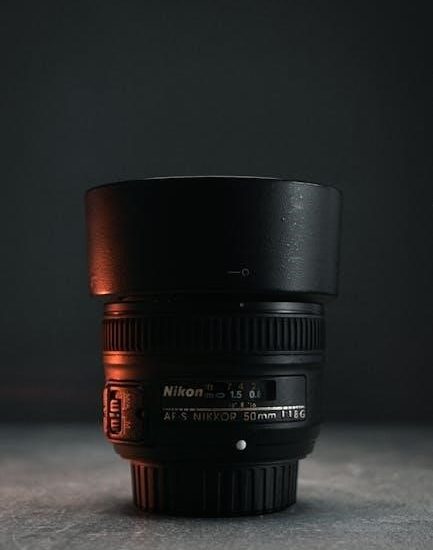The Nikon EM manual is a comprehensive guide for understanding and operating the camera, available as a free 57-page PDF download. It details essential components, key features, and maintenance tips, ensuring optimal performance and longevity. The manual covers troubleshooting common issues, compatibility with accessories, and advanced photography techniques, making it an indispensable resource for photographers to unlock the camera’s full potential.
1.1 Overview of the Nikon EM Camera
The Nikon EM is a 35mm film SLR camera introduced in 1979, known for its lightweight and compact design. It features manual controls, compatibility with Nikon Series E lenses, and other Nikkor lenses. The camera offers a fixed shutter speed of 1/90s in Auto mode and battery-dependent operation. Its simplicity and versatility make it a favorite among both professional photographers and enthusiasts, blending ease of use with creative control for high-quality imaging.
1.2 Importance of the Manual for Optimal Camera Use
The Nikon EM manual is essential for mastering the camera’s features, troubleshooting, and maintenance. It provides detailed guidance on operating modes, lens compatibility, and battery management, ensuring optimal performance. By understanding the manual, photographers can maximize image quality, explore creative possibilities, and extend the camera’s longevity. It serves as a vital resource for both beginners and experienced users, unlocking the full potential of the Nikon EM and enhancing their photography experience.
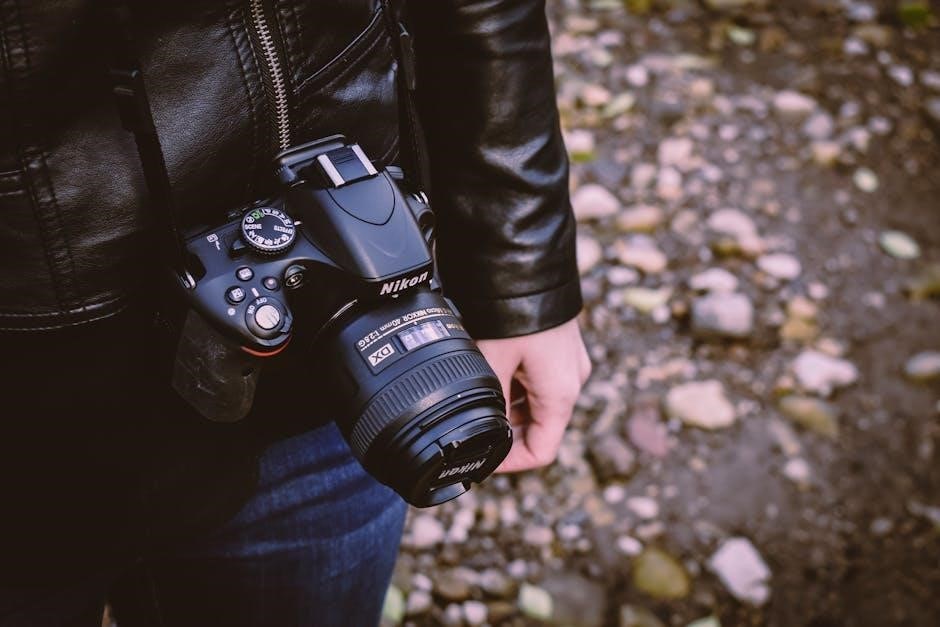
Key Features of the Nikon EM
The Nikon EM offers manual and automatic modes, compatibility with Nikon Series E lenses, and a self-timer, making it versatile for photographers.
2.1 Essential Components and Controls
The Nikon EM features a frame counter, shutter release button, film winding lever, and battery power check button. The lens mounting flange and exposure compensation button are key for operation. The self-timer and shutter operation mode selector offer flexibility, while the neckstrap eyelet ensures portability. These components work together to provide intuitive control and functionality, enhancing the photographer’s experience with the camera.
2.2 Shutter Operation and Modes
The Nikon EM offers versatile shutter operation with multiple modes. In AUTO mode, the camera controls aperture for optimal exposure. M90 mode allows manual control at 1/90 sec, while B mode enables long exposures. Resetting the shutter operation mode selector from AUTO to M90 provides a fixed shutter speed of 1/90 sec. Proper use of these modes ensures precise control over exposure, while safety tips, like avoiding overexposure in bright light, enhance functionality and image quality.
2.3 Compatibility with Lenses and Accessories
The Nikon EM is compatible with Nikon Series E lenses and Ai-type Nikkor lenses, ensuring versatility in photography. It also supports other compatible Nikkor lenses, enhancing creative possibilities. Accessories like the Nikon SB-E Speedlight unit expand functionality. Proper lens mounting and accessory use are detailed in the manual, ensuring optimal performance. Users can explore various combinations to achieve desired results, making the EM adaptable for different photographic needs and styles.
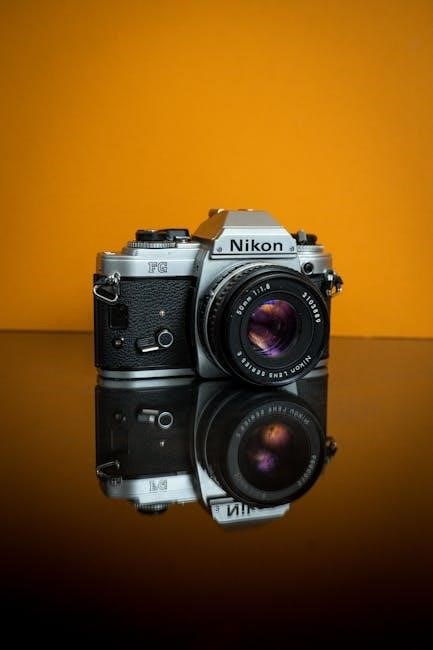
Downloading and Navigating the Manual
The Nikon EM manual is available as a free PDF download from sources like OrphanCameras and ManyManuals. The 57-page document is well-structured, covering features, maintenance, and troubleshooting, making it easy to navigate for optimal camera use and care.
3.1 Sources for the Nikon EM PDF Manual
The Nikon EM manual is available for free download from trusted sources like OrphanCameras.com and ManyManuals.com. These websites provide a 57-page PDF guide, detailing camera operations, maintenance, and troubleshooting. Users can access the manual directly from these platforms, ensuring easy navigation and comprehensive understanding of the camera’s features and functions.
3.2 Understanding the Structure of the Manual
The Nikon EM manual is organized into clear sections, starting with camera nomenclature and moving through operational modes, maintenance, and troubleshooting. Each chapter is designed to guide users through understanding the camera’s components, such as the shutter operation, lens compatibility, and flash photography. The structured format ensures users can easily locate specific information, making the manual an invaluable resource for both beginners and experienced photographers.
Camera Maintenance and Care
Regular cleaning and proper storage are essential to maintain the Nikon EM’s performance. Ensure lenses are free from dust and scratches, and check battery power regularly for optimal functionality.
4.1 Cleaning and Protecting the Camera
Regular cleaning is essential to maintain the Nikon EM’s performance. Use a soft, dry cloth to wipe the camera body and lenses, avoiding harsh chemicals. For stubborn marks, a slightly dampened cloth may be used, but ensure no moisture enters the camera. Protect the camera from dust by using lens caps and storing it in a dry, cool place. Avoid exposure to direct sunlight or extreme temperatures to preserve functionality and longevity.
4.2 Battery Management and Power Check
Proper battery management is crucial for the Nikon EM’s operation. Use the battery power check button to verify battery status via the LED indicator. Replace batteries when power is low, ensuring reliable performance. Avoid extreme temperatures that may drain or damage batteries. If the battery is weak, reset the shutter mode to M90 for consistent operation. Regularly check battery life to prevent unexpected power failures during photography sessions.
Troubleshooting Common Issues
Common issues with the Nikon EM include shutter speed problems and battery-related malfunctions. Check the battery power and ensure proper shutter mode settings for reliable operation.
5.1 Resolving Shutter Speed Problems
To address shutter speed issues, reset the shutter operation mode selector from AUTO to M90, providing a fixed 1/90 sec speed. Ensure proper battery power and mode settings for reliable operation. This step resolves common malfunctions and ensures accurate exposures. Refer to the manual for detailed guidance on troubleshooting and maintaining optimal shutter functionality.
5.2 Addressing Battery and Power Issues
For battery and power issues, check the power LED lamp to ensure proper functionality. Replace exhausted batteries and avoid using incompatible ones. If problems persist, reset the shutter mode selector and verify battery compartment connections. Regular maintenance ensures reliable power supply and optimal camera performance. Consult the manual for detailed troubleshooting steps and battery care tips to maintain your Nikon EM’s efficiency.

Flash Photography with the Nikon EM
This chapter covers using the Nikon SB-E Speedlight Unit, providing safety tips to avoid eye damage and offering setup guidance for effective flash synchronization and operation.
6.1 Using the Nikon SB-E Speedlight Unit
The Nikon SB-E Speedlight Unit is a key accessory for flash photography with the EM. It offers manual control and compatibility with the camera’s shutter system. Safety tips emphasize avoiding direct flash into subjects’ eyes to prevent damage. Setup involves mounting the unit, adjusting settings, and ensuring proper synchronization. The SB-E enhances creativity, providing consistent illumination for various lighting conditions while maintaining the EM’s portability and functionality. Proper use ensures high-quality results in low-light environments.
6.2 Safety Tips for Flash Photography
When using the Nikon SB-E Speedlight Unit, ensure safety by avoiding direct flash into subjects’ eyes at close range, as it may cause damage or blindness. Keep the flash away from reflective surfaces to prevent overexposure. Use the flash in well-ventilated areas to avoid overheating. Store the unit properly to maintain functionality and longevity. Always follow the manufacturer’s guidelines for optimal performance and safety during flash photography sessions with the Nikon EM camera.
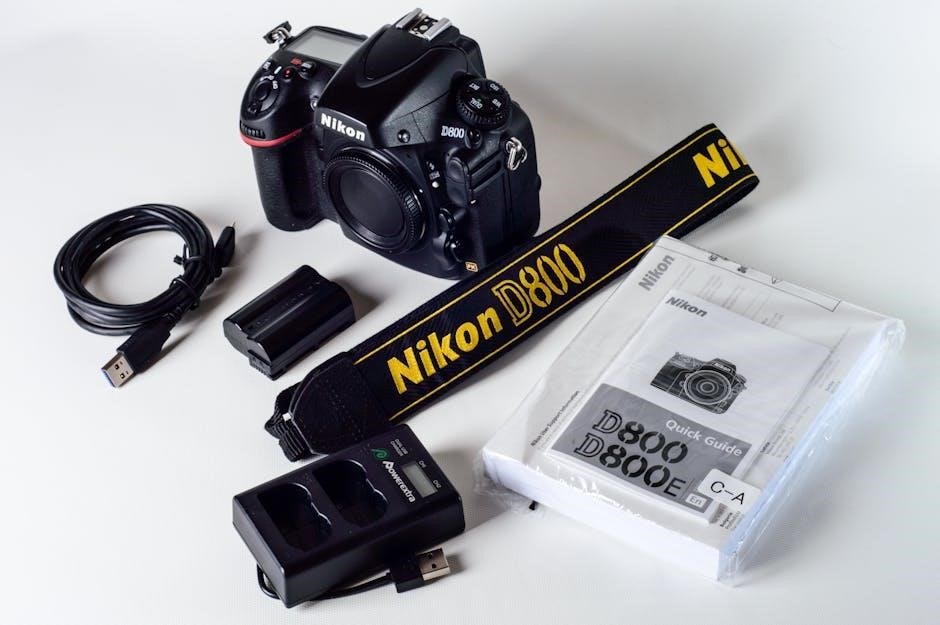
Lens and Accessory Compatibility
The Nikon EM supports various Nikkor lenses, including Series E and AI-type, ensuring compatibility and versatility. It also works with optional accessories like the SB-E Speedlight, enhancing functionality.
7.1 Nikon Series E Lenses
Nikon Series E lenses are designed to be compact and lightweight, offering exceptional optical quality. These lenses are fully compatible with the Nikon EM, providing a cost-effective yet high-performance option for photographers. They support manual focusing even in autofocus mode, allowing precise control. The Series E range includes popular focal lengths, making them ideal for everyday photography and creative projects, ensuring versatility and ease of use.
7.2 Other Usable Lenses and Accessories
Beyond Series E lenses, the Nikon EM supports a variety of AI-type Nikkor lenses and other compatible optics. These lenses, including wide-angle and telephoto options, enhance creativity and versatility. Additionally, the camera is compatible with accessories like the Nikon SB-E Speedlight for flash photography. These lenses and accessories ensure the Nikon EM remains a versatile tool for photographers, offering flexibility to adapt to diverse shooting needs and styles.

Basic Photography Techniques
Mastering basic techniques with the Nikon EM involves proper camera handling, precise focusing, and understanding exposure settings. These fundamentals ensure sharp, well-lit images and effective flash use.
8.1 Proper Camera Handling
Proper handling of the Nikon EM ensures stability and clarity in your shots. Hold the camera firmly with both hands, one gripping the body and the other supporting the lens. Keep your elbows close to your body for better stability and to minimize camera shake. Use the neck strap for added security, especially in crowded or dynamic shooting environments. Proper posture and a steady stance further enhance image quality, allowing you to capture sharp, professional-looking photographs effortlessly.
8.2 Focusing and Exposure Basics
Mastering focusing and exposure is essential for capturing sharp, well-lit images with the Nikon EM. Use manual focus for precise control, ensuring your subject is sharp by aligning the focus mark. For exposure, the camera offers Aperture Priority and manual modes. The built-in light meter assists in balancing settings, while the exposure compensation button fine-tunes brightness. Experiment with these controls to achieve creative results and enhance your photography skills.
Advanced Features and Settings
The Nikon EM offers advanced features like manual mode for precise control and exposure compensation for fine-tuning brightness. These settings allow photographers to explore creative possibilities and enhance image quality effectively.
9.1 Manual Mode and Exposure Compensation
Manual mode on the Nikon EM allows photographers to control both aperture and shutter speed, enabling precise adjustments for creative shooting. Exposure compensation fine-tunes brightness, ensuring balanced results. This feature is particularly useful in challenging lighting conditions, offering flexibility to achieve desired effects. By mastering manual mode and exposure compensation, users can unlock the camera’s full potential for professional-quality images.
9.2 Using the Self-Timer and Other Advanced Functions
The Nikon EM features a self-timer, allowing a 10-second delay before shooting, ideal for minimizing camera shake in handheld shots. Additional advanced functions include manual focus override, enabling precise control over depth of field. These features enhance shooting versatility, catering to both amateur and professional photographers seeking creative control and precision in their work. Mastering these functions expands the camera’s capabilities for diverse photography scenarios.
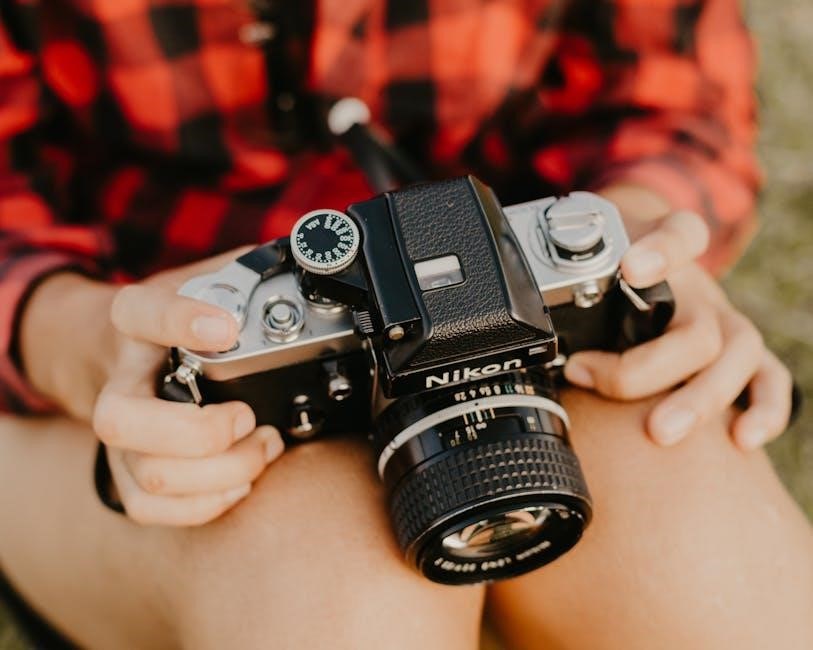
Specifications and Technical Details
The Nikon EM is a 35mm SLR camera with a Silicon Photo Diode meter for exposure control and manual operation modes, offering precise mechanical functionality.
10.1 Key Specifications of the Nikon EM
The Nikon EM features a 35mm film format and manual focus capabilities. It includes a through-the-lens (TTL) metering system with a Silicon Photo Diode sensor for accurate exposure control. The camera offers manual operation mode with shutter speeds from 1/90 sec to B, providing photographers with precise mechanical functionality. It is compatible with Nikon Series E lenses and other AI-type Nikkor lenses, ensuring versatility.
10.2 Technical Comparisons with Other Models
The Nikon EM stands out among its contemporaries with its compact design and lightweight construction, making it a portable choice for photographers. Unlike the Nikon FM2, it lacks weather sealing but offers a more affordable option with similar functionality. Compared to the FE series, the EM focuses on manual operation, providing a straightforward interface for those who prefer hands-on control without advanced automation, appealing to both enthusiasts and collectors alike.

Vintage Camera Collecting and the Nikon EM
The Nikon EM is a cherished favorite among vintage camera collectors, admired for its compact design and enduring functionality. Its historical significance and compatibility with legacy lenses make it a standout piece, connecting enthusiasts with the evolution of photography while preserving the charm of analog imaging.
11.1 The Appeal of Vintage Cameras
Vintage cameras captivate enthusiasts with their timeless design, mechanical precision, and nostalgic charm. The tactile experience of film photography and the artistry of manual controls evoke a creative connection. Collectors appreciate their historical significance and the unique character each camera embodies, making them treasured possessions that bridge the past and present in the world of photography.
11.2 The Nikon EM in the Context of Camera History
The Nikon EM, introduced in 1979, holds a notable place in camera history as one of Nikon’s earliest compact 35mm SLRs. Known for its electronic shutter and aperture-priority mode, it catered to both beginners and professionals. Its innovative design and affordability made it a popular choice, influencing the development of future Nikon models. Today, it remains a sought-after collectible, reflecting Nikon’s commitment to quality and innovation in photography.
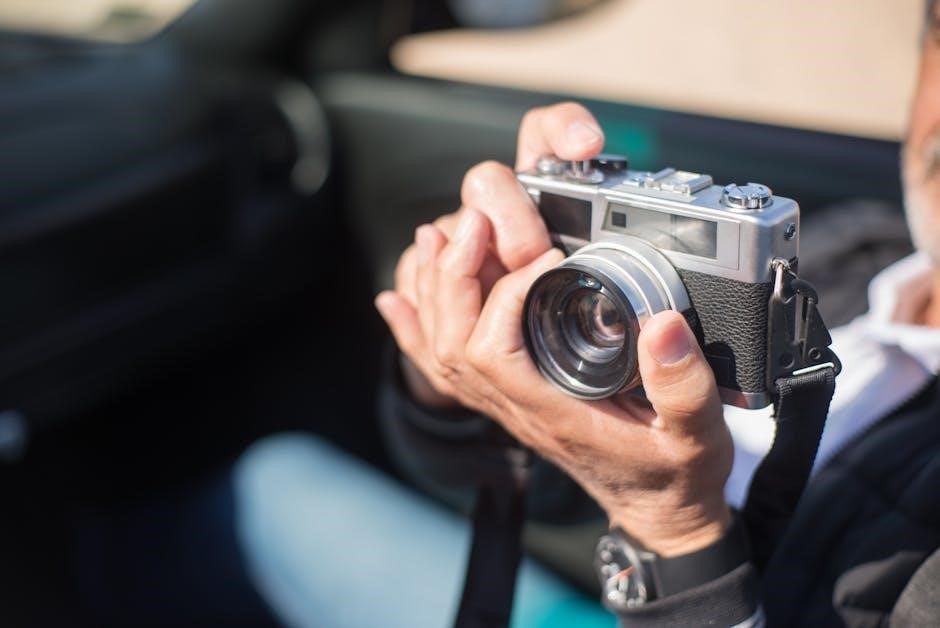
Tips for Getting the Most Out of Your Nikon EM
Experiment with manual mode, explore creative possibilities, and optimize settings for various lighting conditions to enhance your photography experience and capture high-quality images consistently.
12.1 Maximizing Image Quality
To maximize image quality with the Nikon EM, use manual mode for precise control over aperture and shutter speed. Adjust exposure compensation for optimal lighting and experiment with ISO settings to minimize noise. Ensure proper lens maintenance and use high-quality Nikon Series E lenses for sharp results. Familiarize yourself with the camera’s metering system and practice proper handling techniques to avoid camera shake and blur, ensuring crisp and professional-looking photographs.
12.2 Exploring Creative Possibilities
Experiment with the Nikon EM’s manual controls to explore creative photography techniques. Use the self-timer for tripod-based shots and the flash for dynamic low-light effects. Adjust shutter speed and aperture to capture motion blur or depth of field. Explore macro photography with compatible lenses or create unique effects with multiple exposures. The camera’s simplicity encourages experimentation, allowing photographers to push boundaries and express their artistic vision through diverse shooting styles and settings.
The Nikon EM manual is an indispensable resource for photographers, providing detailed guidance to unlock the camera’s full potential and explore creative possibilities effectively.
13.1 Final Thoughts on the Nikon EM Manual
The Nikon EM manual is a vital resource for photographers, offering a user-friendly guide to maximize the camera’s capabilities. From basic operations to advanced techniques, it ensures optimal use. With detailed troubleshooting and maintenance tips, it empowers photographers of all levels. Its clear structure and comprehensive coverage make it an essential companion for anyone seeking to master the Nikon EM and enhance their photography skills.
13.2 Encouragement to Explore Further
With the Nikon EM manual as your guide, take the next step to explore the camera’s full potential. Experiment with advanced techniques, delve into creative possibilities, and refine your photography skills. The manual’s insights, combined with practice, will empower you to capture stunning images. Join communities, share experiences, and continue learning to unlock new creative horizons with your Nikon EM, ensuring every shot tells a unique story.

Additional Resources
For further learning, explore recommended reading and websites like orphancameras.com for PDF manuals. Join online forums and communities to connect with Nikon EM enthusiasts and share insights.
14.1 Recommended Reading and Websites
For in-depth knowledge, visit orphancameras;com, which offers free PDF manuals and guides for the Nikon EM. The official Nikon website also provides user manuals and technical specifications. Additionally, online forums like Nikon enthusiasts’ communities and photography blogs are excellent for troubleshooting and learning creative techniques. These resources ensure comprehensive understanding and mastery of the Nikon EM camera.
14.2 communities and Forums for Nikon EM Enthusiasts
14.2 Communities and Forums for Nikon EM Enthusiasts
Engage with Nikon EM enthusiasts through dedicated forums and communities. Websites like Nikon enthusiasts’ forums and photography blogs offer valuable insights, troubleshooting tips, and creative techniques. These platforms foster knowledge sharing and connections among photographers passionate about vintage cameras like the Nikon EM. Participating in these communities enhances your understanding and appreciation of the camera while providing access to a wealth of shared experiences and expertise.

